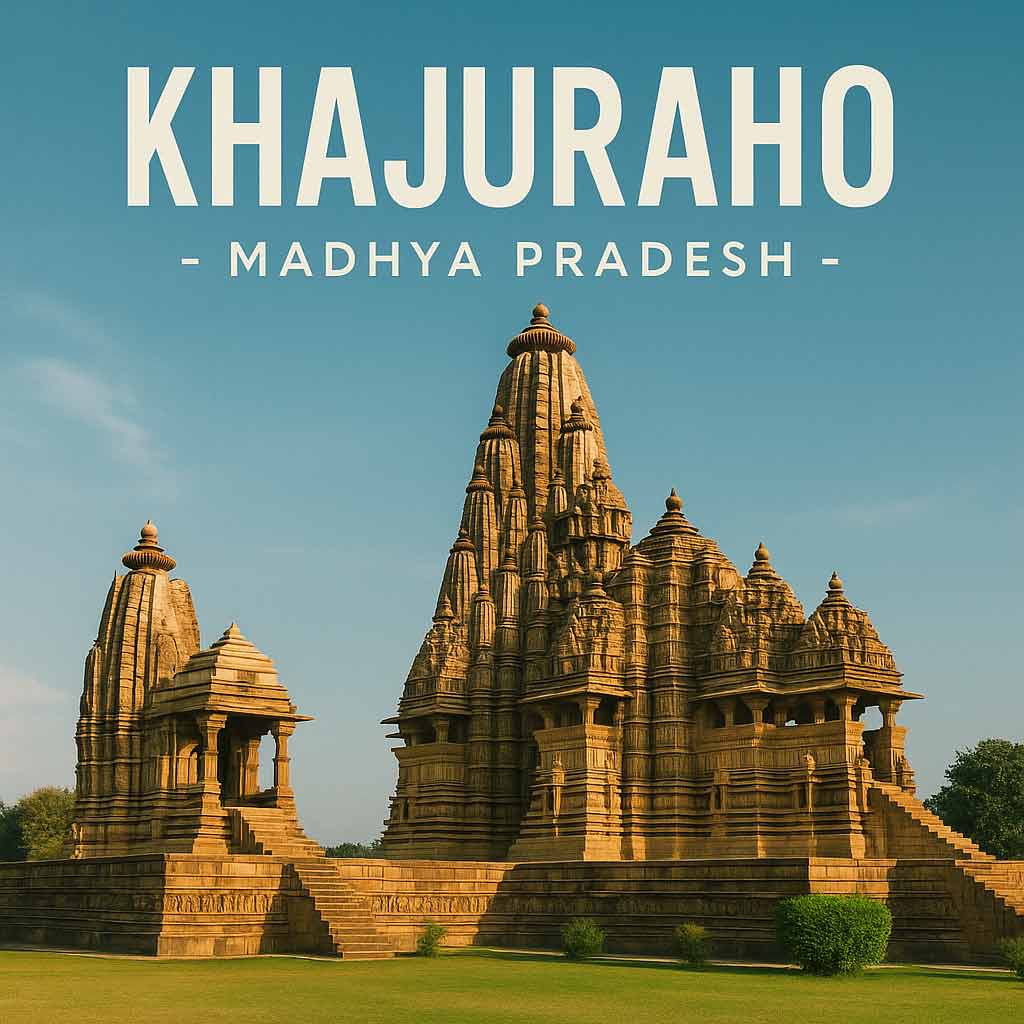Khajuraho – Madhya Pradesh
– The Timeless Temple City of Madhya Pradesh
India’s fantasy land. A haven for the foreigners too. With long silvery beaches and swaying palms. The local people are very friendly and warm, welcoming tourists amidst their festivals and carnivals.
Goa is simply divine in season with water games and Shacks selling mouth watering delicacies. During Christmas and New year everyone is out on the streets singing and dancing. The majority of the population are of Latin-Roman origin. Goa being a coastal area, Coconuts and Cashew nuts are abundant.It is from these Cashew fruits that the famous liquor Fenny is extracted.

Khajuraho – The Timeless Temple City of Madhya Pradesh
Located in the heart of India, Khajuraho is a breathtaking testament to the artistic and architectural brilliance of ancient India. Situated in the Chhatarpur district of Madhya Pradesh, Khajuraho is globally renowned for its magnificent group of temples adorned with intricate carvings that depict every aspect of human life. Designated as a UNESCO World Heritage Site, Khajuraho stands as a living example of India’s cultural richness, spirituality, and refined artistry that flourished over a thousand years ago.
A Journey Through History
The Khajuraho temples were built between the 9th and 12th centuries by the Chandela dynasty, one of the most powerful Rajput clans of Central India. Historical records suggest that there were originally 85 temples, of which about 25 have survived the passage of time. These temples were built over a span of nearly 200 years, representing a golden era of creativity and devotion.
After the decline of the Chandelas, Khajuraho was largely forgotten and covered by dense forests for centuries. It was rediscovered in the 19th century by British engineer T.S. Burt in 1838, who was astonished by the grandeur and detail of the sculptures. Today, these temples are preserved and celebrated as one of India’s most treasured heritage sites.
The Art and Architecture
The temples of Khajuraho are renowned for their Nagara-style architecture, characterized by soaring shikharas (spires), elevated platforms, and detailed carvings that adorn every inch of their surfaces. Built primarily of sandstone, each temple sits on a high base platform, symbolizing the elevation from the earthly world to the divine.
The sculptures of Khajuraho are what make it truly exceptional. They depict an astonishing range of themes — from gods and goddesses, celestial beings, musicians, and dancers to warriors and mythical creatures. Perhaps the most talked-about aspect of Khajuraho is its erotic sculptures, which represent just a small fraction (around 10%) of the carvings. Contrary to popular perception, these are not meant to be merely sensual but symbolize the celebration of life, love, and spiritual awakening.
In Indian philosophy, human love is viewed as a path to divine union, and these depictions reflect that profound connection between the physical and spiritual realms. The temples, in essence, celebrate the completeness of existence — where earthly desires, devotion, and enlightenment coexist in harmony.
The Main Temple Groups
The Khajuraho temples are divided into three main groups: the Western, Eastern, and Southern groups, each representing different deities and architectural styles.
Western Group: This is the largest and most celebrated cluster, home to the Kandariya Mahadeva Temple, dedicated to Lord Shiva. It is the grandest of all, with more than 800 sculptures depicting gods, celestial beings, and human figures in fluid, lifelike poses. Other notable temples here include the Lakshmana Temple and the Devi Jagadambi Temple, all celebrated for their intricacy and grace.
Eastern Group: These temples are mainly Jain temples, including the Parshvanatha Temple and Adinatha Temple, which display exquisite carvings with less emphasis on sensuality and more on spiritual symbolism.
Southern Group: This smaller group includes the Duladeo Temple and Chaturbhuja Temple, showcasing later developments in temple design and artistry.
Together, these temples form a microcosm of Indian spirituality, celebrating both divine and human experiences.
Culture and Experience
Khajuraho is not only a site of ancient marvels but also a vibrant center of art and culture. The Khajuraho Dance Festival, held every February, brings together classical dancers from across India who perform traditional dance forms like Bharatanatyam, Kathak, Odissi, and Kuchipudi against the stunning backdrop of the illuminated temples. The event is a celebration of India’s performing arts heritage and adds a magical dimension to the site.
Visitors can also explore the Archaeological Museum, which houses sculptures and artifacts excavated from the area, offering deeper insights into Chandela art and society.
Beyond the temples, Khajuraho’s serene rural surroundings, with its lakes and greenery, provide a peaceful retreat for travelers seeking both spiritual and aesthetic experiences.
Symbolism and Legacy
Khajuraho’s temples stand as a profound expression of the Hindu philosophy of life — encompassing dharma (duty), artha (prosperity), kama (desire), and moksha (liberation). The carvings are not just ornamental but narrative, representing the eternal cycle of creation and the harmony between body, mind, and spirit.
The legacy of Khajuraho endures as a reminder that art and spirituality can coexist in perfect balance. It tells the world that ancient India was not merely a land of rituals and religion but also of imagination, sensuality, and intellectual depth.
Conclusion
Khajuraho is far more than a collection of temples — it is a poetic reflection of human existence in stone. Every sculpture, every spire, and every carving speaks of a civilization that saw divinity in every aspect of life. For travelers, historians, and seekers alike, Khajuraho remains an unforgettable journey into the soul of India — a place where time stands still, and beauty speaks the language of eternity.
